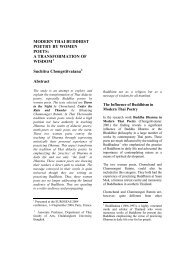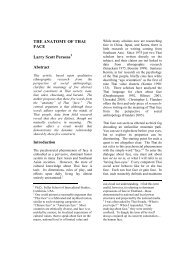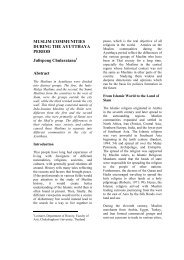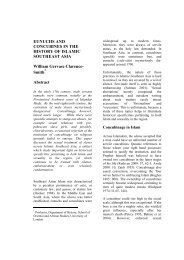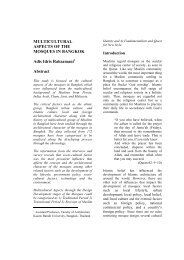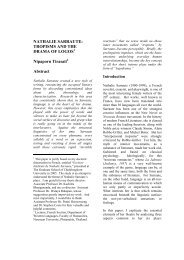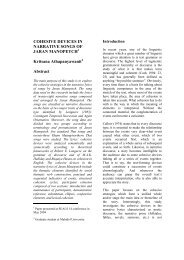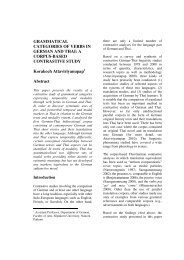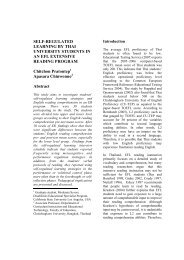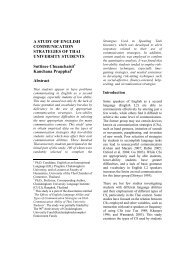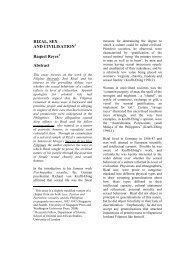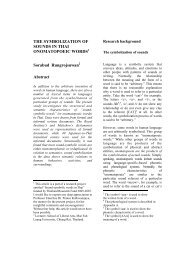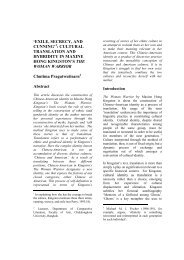Filial Piety and Chastity in Nguyen Du's The Tale of Kieu - Manusya ...
Filial Piety and Chastity in Nguyen Du's The Tale of Kieu - Manusya ...
Filial Piety and Chastity in Nguyen Du's The Tale of Kieu - Manusya ...
You also want an ePaper? Increase the reach of your titles
YUMPU automatically turns print PDFs into web optimized ePapers that Google loves.
<strong>Filial</strong> <strong>Piety</strong> <strong>and</strong> <strong>Chastity</strong> <strong>in</strong> <strong>Nguyen</strong> Du’s <strong>The</strong> <strong>Tale</strong> <strong>of</strong> <strong>Kieu</strong>underst<strong>and</strong> a part <strong>of</strong> Buddhism. On theother h<strong>and</strong>, knowledge <strong>of</strong> Buddhism canhelp readers underst<strong>and</strong> <strong>The</strong> <strong>Tale</strong> <strong>of</strong> <strong>Kieu</strong>more clearly (repr<strong>in</strong>ted <strong>in</strong> <strong>Nguyen</strong> NgocThien 2002: 568). <strong>The</strong> follow<strong>in</strong>g exampleshows how the idea <strong>of</strong> Karma is portrayed<strong>in</strong> the story. As revealed <strong>in</strong> the story, thebad characters like Ma Giam S<strong>in</strong>h or TuBa are punished. Meanwhile, the goodpeople like <strong>Kieu</strong> are rewarded after theyhave paid <strong>of</strong>f their s<strong>in</strong>s. As shown at theend <strong>of</strong> the story, <strong>Kieu</strong> can enjoy thereward <strong>of</strong> her good deeds.....<strong>and</strong> her previous s<strong>in</strong>s have beenwashed out.Sometimes, heaven is also<strong>in</strong>dulgent to the human be<strong>in</strong>gs:Those who have paid <strong>of</strong>f theirprevious debts,May expect compensation <strong>in</strong> theirsentimental future. (p. 367)After hav<strong>in</strong>g heard about Vuong’smisfortunes <strong>and</strong> the sacrifice <strong>of</strong> <strong>Kieu</strong>, KimTrong responds to <strong>Kieu</strong>’s request bymarry<strong>in</strong>g Thuy Van, <strong>Kieu</strong>’s younger sister.He never gives up search<strong>in</strong>g for <strong>Kieu</strong>.Towards the end <strong>of</strong> the story, <strong>Kieu</strong> isrescued by a Buddhist nun <strong>and</strong> returned toher family <strong>and</strong> loved ones. Here, the idea<strong>of</strong> love is conveyed <strong>in</strong>terest<strong>in</strong>gly as it isrevealed that the subsequent marriagebetween <strong>Kieu</strong> <strong>and</strong> Kim Trong is notconsummated. <strong>The</strong>y decide to livetogether as friends <strong>in</strong>stead <strong>of</strong> as husb<strong>and</strong><strong>and</strong> wife. As shown <strong>in</strong> the story:Of love <strong>and</strong> friendship theyfulfilled both claims-<strong>The</strong>y shared no bed but joys <strong>of</strong>lute <strong>and</strong> verse.Now they sipped w<strong>in</strong>e, nowplayed a game <strong>of</strong> go,Admir<strong>in</strong>g flowers, wait<strong>in</strong>g for themoon.<strong>The</strong>ir wishes all came true s<strong>in</strong>cefate so willed,And <strong>of</strong> two loves marriage madetwo friends.(Huynh Sanh Thong 1996: 167)Thus, their love is not connected tosexuality, draw<strong>in</strong>g a sharp contrast withthe sexuality <strong>of</strong> the prostitution <strong>in</strong> which<strong>Kieu</strong> engaged dur<strong>in</strong>g 15 years <strong>of</strong> misery.In fact, this k<strong>in</strong>d <strong>of</strong> platonic love was newto the social context <strong>of</strong> the early 19 thcentury Vietnam. Traditionally, <strong>in</strong>Vietnamese society, marriage was notbased on love but on an agreementbetween two families. Thus, it wasdeterm<strong>in</strong>ed by consideration <strong>of</strong> factorssuch as wealth, social status <strong>and</strong>reproduction, love not be<strong>in</strong>g taken <strong>in</strong>toaccount. Marriage was related toreproduction <strong>and</strong> economic imperatives,<strong>and</strong> women had to rely entirely on men.Traditionally, Vietnamese women werecontrolled by ‘tam tong’ or the threesubmissions, which divided a woman’slife <strong>in</strong>to three stages: when she was young,she had to obey her father; when married,she depended on her husb<strong>and</strong>; if herhusb<strong>and</strong> died, she had to obey her eldestson (Marr 1984: 192). Similarly, therelationships <strong>in</strong> the society were ma<strong>in</strong>lycategorised <strong>in</strong>to the ‘tam cuong’, the threesocial bonds, which <strong>in</strong>cluded therelationships <strong>of</strong> ruler-subord<strong>in</strong>ate; fatherson;<strong>and</strong> husb<strong>and</strong>-wife (Pham Van Khoai2003: 65). Thus, the platonic love between<strong>Kieu</strong> <strong>and</strong> Kim Trong would not beimag<strong>in</strong>able at the time the poem wascomposed. Moreover, a friendshipbetween a man <strong>and</strong> a woman, asdemonstrated <strong>in</strong> the relationship <strong>of</strong> <strong>Kieu</strong><strong>and</strong> Kim Trong, did not fit any <strong>of</strong> the types<strong>of</strong> social bonds described by Confucius.71



